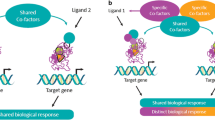Abstract
Fibrates and WY-14643 are widely used as lipid-lowering drugs via modulation of peroxisome proliferator-activated receptor alpha (PPAR α) for the treatment of a wide range of metabolic disorders. Here, to address the question whether PPAR α agonists can affect the enzymatic activity of 11beta-hydroxysteroid dehydrogenase1 (11β-HSD1), we tested fibrates and WY-14643 for the inhibition of cellular 11β-HSD1 activity in C2C12 myotubes. Only fenofibrate but not fenofibric acid, an active agonist of PPAR α, exerted a potent inhibitory activity in the cell based assay, showing an IC50 of 1.6 μM. Furthermore, we also demonstrated that the masking of carboxyl group in fenofibric acid via esterification or amidation was required for the inhibitory potencies of fenofibric acid derivatives against 11β-HSD1. In this presentation, we propose that fenofibrate can display a pharmacodynamic role distinct from fenofibric acid through masking of carboxyl group in fenofibric acid.




Similar content being viewed by others
References
Dayspring T, Pokrywka G (2006) Fibrate therapy in patients with metabolic syndrome and diabetes mellitus. Curr Atheroscler Rep 8:356–364
Latruffe N, Cherkaoui Malki M, Nicolas-Frances V, Clemencet MC, Jannin B, Berlot JP (2000) Regulation of the peroxisomal beta-oxidation-dependent pathway by peroxisome proliferator-activated receptor alpha and kinases. Biochem Pharmacol 60:1027–1032
Hermanowski-Vosatka A, Gerhold D, Mundt SS, Loving VA, Lu M, Chen Y, Elbrecht A, Wu M, Doebber T, Kelly L, Milot D, Guo Q, Wang PR, Ippolito M, Chao YS, Wright SD, Thieringer R (2000) PPARalpha agonists reduce 11beta-hydroxysteroid dehydrogenase type 1 in the liver. Biochem Biophys Res Commun 279:330–336
Nakano S, Inada Y, Masuzaki H, Tanaka T, Yasue S, Ishii T, Arai N, Ebihara K, Hosoda K, Maruyama K, Yamazaki Y, Shibata N, Nakao K (2007) Bezafibrate regulates the expression and enzyme activity of 11beta-hydroxysteroid dehydrogenase type 1 in murine adipose tissue and 3T3–L1 adipocytes. Am J Physiol Endocrinol Metab 292:E1213–E1222
Srivastava RA (2009) Fenofibrate ameliorates diabetic and dyslipidemic profiles in KKAy mice partly via down-regulation of 11beta-HSD1, PEPCK and DGAT2. Comparison of PPARalpha, PPARgamma, and liver x receptor agonists. Eur J Pharmacol 607:258–263
Lu NZ, Wardell SE, Burnstein KL, Defranco D, Fuller PJ, Giguere V, Hochberg RB, McKay L, Renoir JM, Weigel NL, Wilson EM, McDonnell DP, Cidlowski JA (2006) International Union of Pharmacology. LXV. The pharmacology and classification of the nuclear receptor superfamily: glucocorticoid, mineralocorticoid, progesterone, and androgen receptors. Pharmacol Rev 58:782–797
Brindley DN (1995) Role of glucocorticoids and fatty acids in the impairment of lipid metabolism observed in the metabolic syndrome. Int J Obes Relat Metab Disord 19(Suppl 1):S69–S75
Whorwood CB, Donovan SJ, Flanagan D, Phillips DI, Byrne CD (2002) Increased glucocorticoid receptor expression in human skeletal muscle cells may contribute to the pathogenesis of the metabolic syndrome. Diabetes 51:1066–1075
Cho YS, Kim CH, Cheon HG (2009) Cell-based assay for screening 11beta-hydroxysteroid dehydrogenase 1 inhibitors. Anal Biochem 392:110–116
Sandeep TC, Yau JL, MacLullich AM, Noble J, Deary IJ, Walker BR, Seckl JR (2004) 11Beta-hydroxysteroid dehydrogenase inhibition improves cognitive function in healthy elderly men and type 2 diabetics. Proc Natl Acad Sci USA 101:6734–6739
Kuwabara K, Murakami K, Todo M, Aoki T, Asaki T, Murai M, Yano J (2004) A novel selective peroxisome proliferator-activated receptor alpha agonist, 2-methyl-c-5-[4-[5-methyl-2-(4-methylphenyl)-4-oxazolyl]butyl]-1,3-dioxane-r-2-carboxylic acid (NS-220), potently decreases plasma triglyceride and glucose levels and modifies lipoprotein profiles in KK-Ay mice. J Pharmacol Exp Ther 309:970–977
Shimomura K, Shimizu H, Ikeda M, Okada S, Kakei M, Matsumoto S, Mori M (2004) Fenofibrate, troglitazone, and 15-deoxy-Delta12, 14-prostaglandin J2 close KATP channels and induce insulin secretion. J Pharmacol Exp Ther 310:1273–1280
Thomas J, Bramlett KS, Montrose C, Foxworthy P, Eacho PI, McCann D, Cao G, Kiefer A, McCowan J, Yu KL, Grese T, Chin WW, Burris TP, Michael LF (2003) A chemical switch regulates fibrate specificity for peroxisome proliferator-activated receptor alpha (PPARalpha) versus liver X receptor. J Biol Chem 278:2403–2410
Rath NP, Haq W, Balendiran GK (2005) Fenofibric acid. Acta Crystallogr C 61:o81–o84
Caldwell J (1989) The biochemical pharmacology of fenofibrate. Cardiology 76(Suppl 1):33–41 (discussion 41–44)
Boden G, Homko C, Mozzoli M, Zhang M, Kresge K, Cheung P (2007) Combined use of rosiglitazone and fenofibrate in patients with type 2 diabetes: prevention of fluid retention. Diabetes 56:248–255
Hamelin BA, Turgeon J (1998) Hydrophilicity/lipophilicity: relevance for the pharmacology and clinical effects of HMG-CoA reductase inhibitors. Trends Pharmacol Sci 19:26–37
Szustakowski JD, Lee JH, Marrese CA, Kosinski PA, Nirmala NR, Kemp DM (2006) Identification of novel pathway regulation during myogenic differentiation. Genomics 87:129–138
Potter PM, Wadkins RM (2006) Carboxylesterases-detoxifying enzymes and targets for drug therapy. Curr Med Chem 13:1045–1054
Li P, Callery PS, Gan LS, Balani SK (2007) Esterase inhibition by grapefruit juice flavonoids leading to a new drug interaction. Drug Metab Dispos 35:1203–1208
Khan D, Gilmer JF, Carolan CG, Gaynor JM, Ryder SA (2008) Pharmacological effects of a novel isosorbide-based butyrylcholinesterase inhibitor. Chem Biol Interact 175:231–234
Satoh T, Hosokawa M (1998) The mammalian carboxylesterases: from molecules to functions. Annu Rev Pharmacol Toxicol 38:257–288
Kalgutkar AS, Crews BC, Rowlinson SW, Marnett AB, Kozak KR, Remmel RP, Marnett LJ (2000) Biochemically based design of cyclooxygenase-2 (COX-2) inhibitors: facile conversion of nonsteroidal antiinflammatory drugs to potent and highly selective COX-2 inhibitors. Proc Natl Acad Sci USA 97:925–930
Acknowledgments
This research was supported by the Center for Biological Modulators of the 21st Century Frontier R&D Program, Ministry of Education, Science and Technology, South Korea and by Basic Research Program, KRICT, South Korea. This work was also supported by grant (T3021A to HSJ) from Korea Basic Science Institute.
Author information
Authors and Affiliations
Corresponding author
Rights and permissions
About this article
Cite this article
Kim, C.H., Ramu, R., Ahn, J.H. et al. Fenofibrate but not fenofibric acid inhibits 11beta-hydroxysteroid dehydrogenase 1 in C2C12 myotubes. Mol Cell Biochem 344, 91–98 (2010). https://doi.org/10.1007/s11010-010-0532-4
Received:
Accepted:
Published:
Issue Date:
DOI: https://doi.org/10.1007/s11010-010-0532-4




